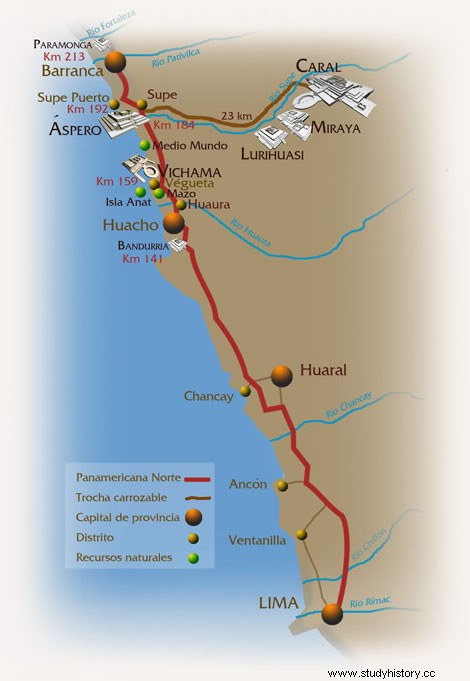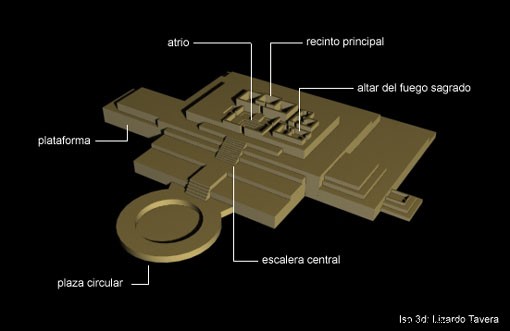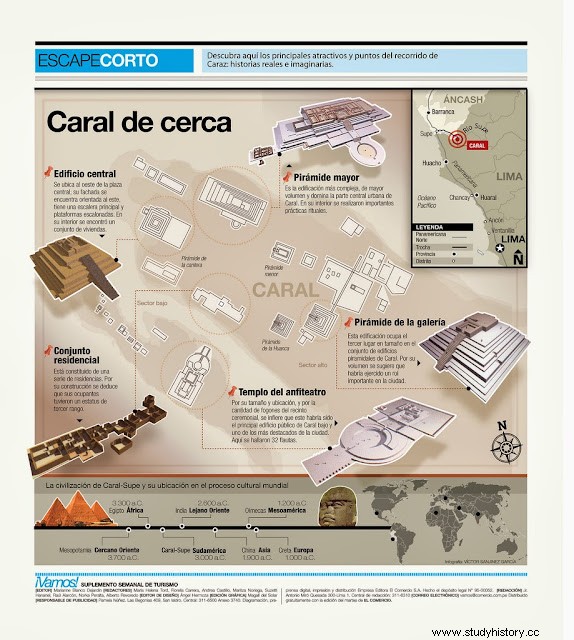Why is Caral important? It is important to clarify problems related to the formation of the state and the emergence of civilization in Peru; the role of agriculture, of natural resources; the role of trade; and the origin of cities .... developed between 3,000 and 11,500 years before Christ; 2,000 years before the construction of Chavín and at least 3,000 years before the arrival of the Incas in the valley.
 Geographical location of the Caral CivilizationWhat does the name Caral mean? The word "Caral" has a very ancient origin, possibly related to the beginnings of the Quechua language. Its meaning has disappeared, although other similar words remain in the region (“Huaral” for example). As for the name of the valley and the river Supe, it would come from “Supay”, which in Quechua means devil, but would also be related to the sacred, venerated and that refuses to disappear.
Geographical location of the Caral CivilizationWhat does the name Caral mean? The word "Caral" has a very ancient origin, possibly related to the beginnings of the Quechua language. Its meaning has disappeared, although other similar words remain in the region (“Huaral” for example). As for the name of the valley and the river Supe, it would come from “Supay”, which in Quechua means devil, but would also be related to the sacred, venerated and that refuses to disappear.What happened in Peru? Unlike other parts of the world, the Peruvian Andes do not have extensive flat valleys that facilitate the development of agriculture. However, despite the difficulties imposed by geography - during the period between 3,000 and 1,500 years before Christ, agriculture was intense and varied in the various regions. On the coast, in addition, this activity was complemented with the use of fish and shellfish. The increase in productivity and interregional exchange allowed the development and emergence of large human settlements. We call this period the Late Archaic.
What was happening in the Supe Valley at that time? Along with Caral, several urban centers arose. There are up to 19 contemporary establishments with Caral, which have public constructions, such as the Chupacigarro site just 1 kilometer away to the west, as well as the sites of Penco, Allpacto, Pueblo Nuevo, Piedra Parada, Huacachi, among others.
What was the Supe Valley like in those days? It was greener and with a greater variety of plants and animals than today. This valley does not have much gradient, which could be useful for agriculture. Also, the water table is very close to the surface, and even today there are outcrops of water and irrigation channels that take advantage of these sources. Near them and on the banks of the river grow plants such as the huarango, the bobo bird, the cane brava, achiote, guava, totora, reed, etc., which make up the vegetation known as "riverside mount", very favorable, moreover, for the sustenance of a varied animal life. During the winter season, the hills become hills, where vizcachas and deer live. This sum of conditions and resources must have been taken advantage of by the ancient inhabitants of the valley.
LIFE IN CARAL:
What were their homes like? Even though they built the temples with stone and clay, the Caral society built their houses using huarango armed with reeds. Later, he made his houses with thatch, based on a huarango structure with reeds joined in pairs, by means of reed fiber ties, forming a design similar to a grid. Likewise, he used different types of finishes for the walls and floors. After the clay stucco layer he applied various kinds of pigment colors:white, yellow, red or blue. each enclosure was always presided over by a central hearth. There was another type of housing, precarious material, possibly temporary, belonging to pilgrims. Of these dwellings we only have the holes of the posts. Its population had been approximately between 1000 and 3000 inhabitants.
 Main square of the City of Caral -Supe
Main square of the City of Caral -SupeWho directed or governed Caral? Within the society of Caral were the priests, who directed the population through the knowledge they accumulated astronomy, space management and time control, necessary for agricultural activities and the construction of architectural structures. They also conducted the storage, distribution and exchange of goods, whether on a local, regional and inter-regional scale.
What did they do? There were people especially in the exchange of cotton - they produced large quantities - with other groups (such as fishermen and inhabitants of mountain valleys), to obtain their barter, certain products, such as fish, molluscs, huayruro, lloque wood, achiote, tutumo, etc.
What did the majority of the population do? The majority of the population was dedicated to the production of cotton, as well as the cultivation of vegetables for their food. They also worked in the collection and hunting of the resources of the mount and the hills, and in the construction of the temples.

What was your religion like? Although there are no written references, we can say that religion in Caral was closely related to the propitiation of good harvests; for which they focused their attention on the observation of the sun and other stars. The buildings are all oriented to the position of the sun at certain times of the year, 25° northeast. Their rites were related to fire. The diversity of forms in the Indian temples that many cultural traditions converged in Caral, from the coast, properly, with others from both the mountains and the jungle. Excavations have found two dead, a child and a young man, their trousseau consisted of stone and shell bead necklaces with offerings of molluscs, baskets, bone and wood objects.
What did they eat and what did they eat? how did they get them? The inhabitants of Caral obtained their food, both from agriculture (squashes and pumpkins), and from the exchange of products with fishermen (anchovetas, sardines, mussels and machas), as well as from the use of the resources of the river hills and the riverside amount, their surplus production stored in warehouses or built for that matter.
What type of art did they have in Caral? Pottery was not yet developed in that period. Despite this, unburned clay figurines, common to other contemporary societies, would be found. Likewise, there has been talk of a pelican bone flute, which was related to the knowledge of music. This instrument was part of an elaborate architectural burial ritual. They decorated some enclosures with high reliefs. Also, in their fabrics, they executed complex designs. Stone beads and molluscs, bone beads with decorations have also been recovered.
From:Sacred City of Caral Ruth Shady Solis & Robert Bustamante Wind
 Infographic on the Cradle of Civilization in Peru - Caral -Supe
Infographic on the Cradle of Civilization in Peru - Caral -Supe 